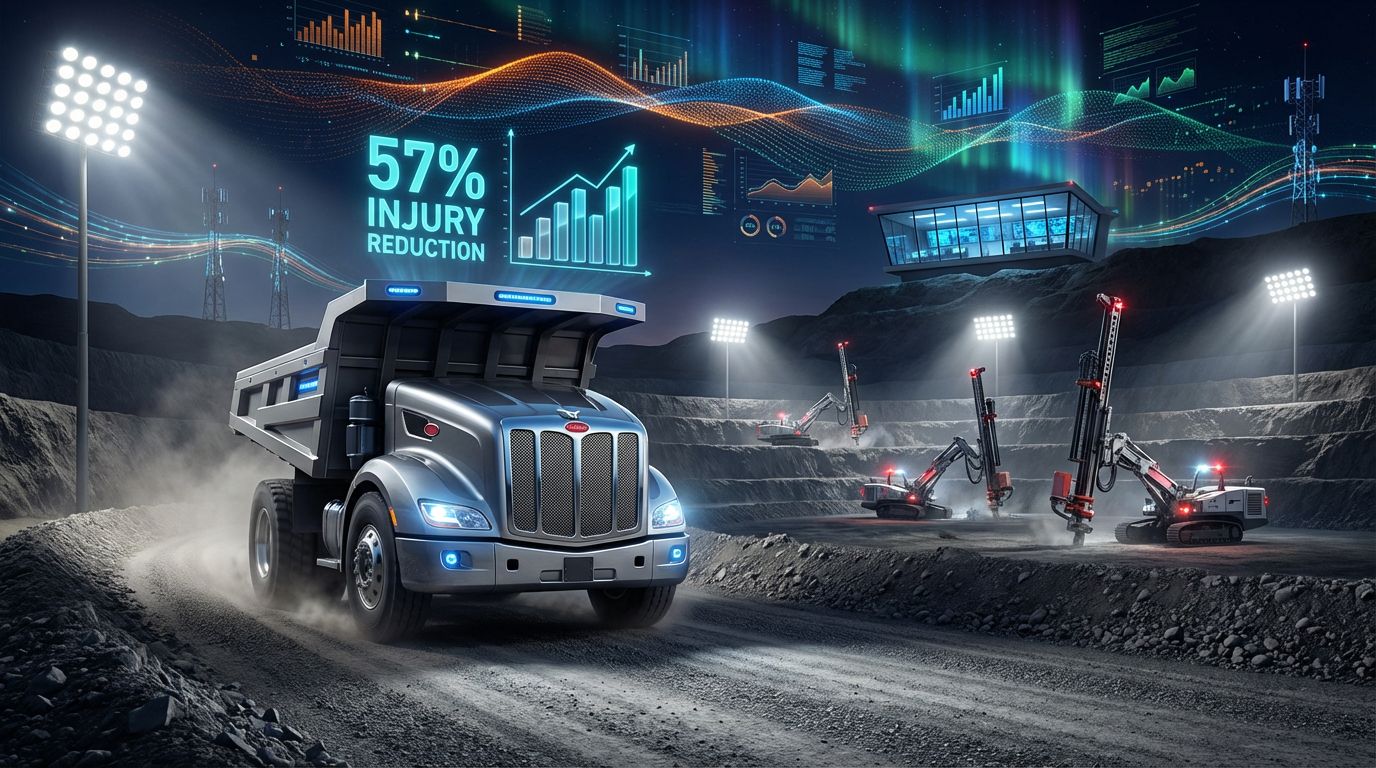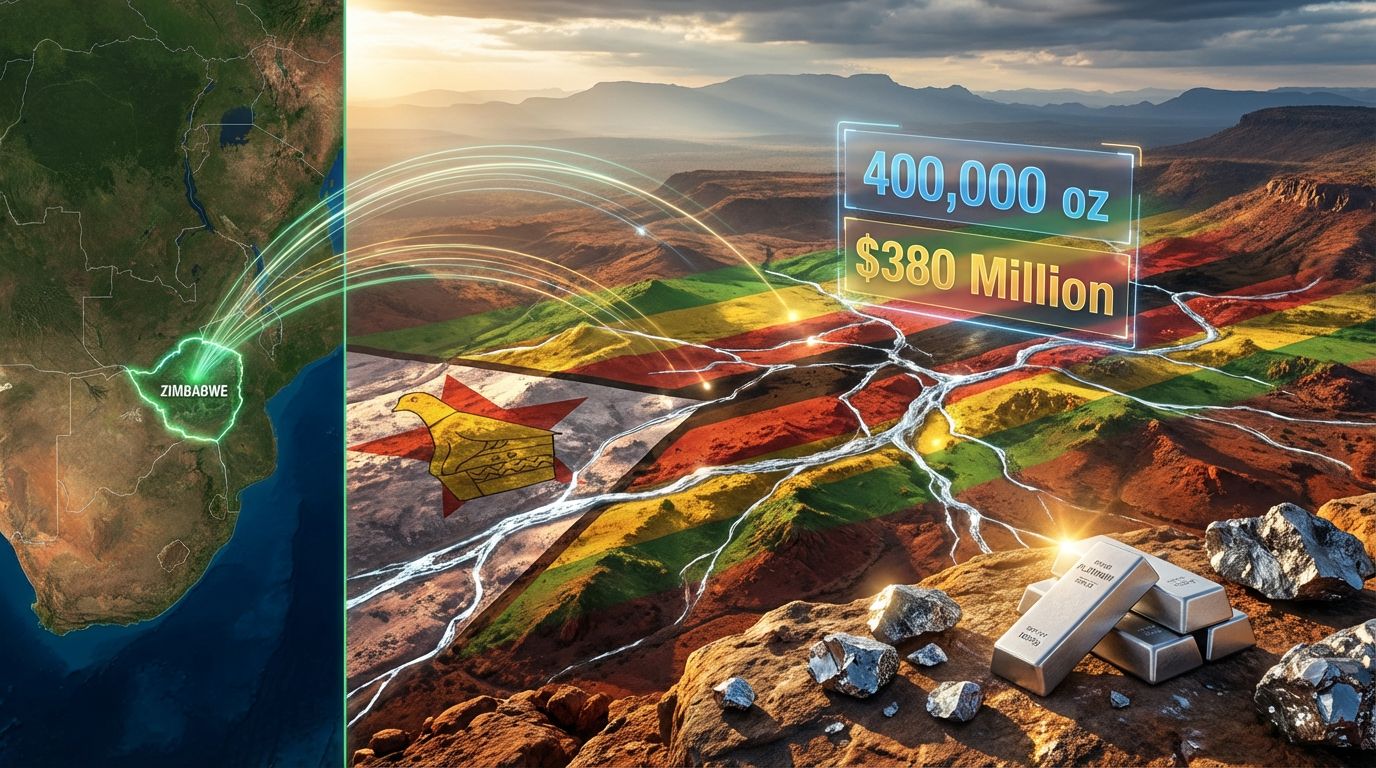How Is AI Transforming the Mining Industry?
Artificial intelligence is revolutionizing the global mining sector, creating unprecedented changes in operational efficiency, safety protocols, and environmental sustainability. With Latin America alone generating over $110 billion in mining revenue (representing 21% of the global base metal market), the integration of AI technologies is reshaping traditional practices through sophisticated data analysis and automation systems. The mining industry stands at the cusp of a technological revolution that promises to deliver efficiency gains exceeding $100 billion worldwide by 2035.
The transformation isn't merely theoretical—mining giants like Rio Tinto, BHP, and Glencore are already implementing AI-driven solutions that optimize everything from resource discovery to extraction and processing. This technological evolution represents a fundamental shift in how mining operations are conducted, monitored, and optimized on a global scale.
What Makes AI a Game-Changer for Mining Operations?
Increased Operational Efficiency
AI technologies are dramatically enhancing mining efficiency through multiple applications. Predictive maintenance systems, like those implemented by Rio Tinto, have reduced equipment downtime by up to 15% by analyzing sensor data to forecast maintenance needs before failures occur. This proactive approach represents a significant departure from traditional scheduled maintenance protocols.
Autonomous vehicle fleets operate continuously without human fatigue constraints, maintaining productivity 24/7 in harsh environments. These self-driving haul trucks navigate complex mining terrains using a combination of GPS, radar, and machine learning algorithms to optimize routes and fuel consumption.
"The implementation of AI-driven predictive maintenance doesn't just reduce downtime—it fundamentally transforms how we approach equipment reliability and operational planning." – Mining industry experts highlight this paradigm shift in maintenance protocols.
Real-time data processing capabilities have revolutionized extraction processes, with AI systems continuously analyzing variables like ore grade, equipment performance, and environmental conditions to make split-second adjustments that optimize yield. Companies like Cerrejón in Colombia have integrated these systems to enhance data‐driven operations.
Perhaps most impressive is AI's impact on resource discovery. Companies like GoldSpot Discoveries have demonstrated how machine learning models can analyze geological data to identify potential mineral deposits with up to 90% accuracy, reducing exploration costs by as much as 50% compared to traditional methods.
Enhanced Safety Protocols
Worker safety has seen remarkable improvements through AI integration. Environmental monitoring systems now detect hazardous conditions before they become dangerous, using networks of sensors that monitor air quality, structural integrity, and other safety parameters in real-time.
AI-powered wearable devices track miner health and safety metrics, monitoring vital signs, proximity to heavy equipment, and exposure to harmful substances. These devices can alert both workers and supervisors to potential safety issues before incidents occur.
Early warning systems for potential disasters represent another critical safety application. Following incidents like the 2021 Tópaga mine explosion in Colombia, mining operations have increasingly deployed AI systems that can detect early signs of methane buildup or structural instability.
The ultimate safety enhancement comes through boosted safety operations. Autonomous equipment can now operate in areas with poor ventilation, unstable ground, or extreme temperatures, keeping human workers at a safe distance while maintaining productivity.
Sustainability Improvements
AI technologies are addressing the mining industry's environmental challenges through multiple pathways. TOMRA's AI-based ore sorting technology has demonstrated the capacity to reduce water and energy usage by an impressive 30% by precisely identifying valuable minerals and separating them from waste rock.
More precise resource extraction has significantly reduced the environmental footprint of mining operations. AI systems can optimize blast patterns, excavation routes, and processing parameters to minimize disturbance to surrounding ecosystems while maximizing resource recovery.
- Reduced water consumption through real-time monitoring and optimization
- Decreased energy usage through equipment efficiency and process optimization
- Minimized land disturbance through precision extraction techniques
- Lower carbon emissions through optimized transportation and processing
Advanced AI algorithms also enhance compliance monitoring for environmental regulations, continuously tracking emissions, water quality, and other parameters to ensure operations remain within regulatory limits—and often exceed them.
What Are the Financial Impacts of AI in Mining?
Investment Requirements and ROI
Implementing AI in mining operations requires significant capital investment. Autonomous vehicles represent one of the largest expenditures, with costs ranging from $5-10 million per autonomous truck or loader. This initial outlay includes not only the equipment itself but also supporting infrastructure like GPS systems, sensors, and control centers.
Despite these substantial upfront costs, the return on investment timeline has proven compelling for early adopters:
- Predictive maintenance systems typically achieve ROI within 18 months
- Autonomous vehicle fleets demonstrate ROI in 2-3 years
- AI-driven exploration systems show returns within 2-5 years
- Process optimization solutions deliver ROI in 1-2 years
The projected efficiency gains from AI implementation are expected to generate over $100 billion in value across the mining industry by 2035. These gains come from multiple sources, including reduced maintenance costs through predictive analytics that identify potential equipment failures before they occur.
Exploration cost reductions of up to 50% represent another major financial benefit, as AI in drilling and blasting systems analyze geological data more effectively than traditional methods, reducing the number of unproductive test drills and focusing resources on high-probability locations.
Operational Cost Savings
Labor costs have traditionally represented 30-40% of operational expenses in mining operations. Through automation of routine tasks like driving, drilling, and basic monitoring, companies can reduce these costs significantly while redeploying human talent to higher-value roles requiring judgment and expertise.
Reduced downtime through predictive maintenance delivers substantial savings. When a haul truck or processing plant experiences unexpected failure, the costs can exceed $100,000 per hour in lost production. AI systems that prevent these failures deliver immediate financial benefits.
Energy optimization through AI-controlled systems represents another major cost advantage. Machine learning algorithms continuously adjust equipment parameters to minimize energy consumption while maintaining production targets. These systems can reduce energy costs by 15-20% in typical mining operations.
Enhanced resource recovery rates directly impact profitability by improving yield from the same raw material inputs. AI-powered processing systems can increase mineral recovery by 5-10% compared to conventional methods, extracting more valuable resources from the same ore.
Market Positioning Benefits
Companies that have embraced AI technologies gain significant competitive advantages. Early adopters like Rio Tinto, BHP, and Glencore have positioned themselves as industry leaders, commanding premium valuations approximately 20% higher than industry peers who have been slower to implement AI solutions.
Improved investor confidence has followed technological leadership, with mining companies demonstrating strong AI capabilities attracting capital more easily and at better terms than competitors. This advantage becomes particularly critical during industry downturns or when raising capital for expansion.
Risk reduction through enhanced predictability represents another financial benefit. AI systems provide more accurate forecasting of production volumes, equipment maintenance needs, and resource yields, allowing for more precise financial planning and reduced operational surprises.
Some mining companies have even discovered new revenue streams through data monetization. The vast amounts of operational and geological data collected through AI systems can be anonymized and commercialized to equipment manufacturers, service providers, and other mining operations.
How Are Mining Companies Implementing AI Today?
Case Studies of Successful Implementation
Drummond in Colombia has emerged as a leader in AI-powered predictive maintenance for mining equipment. Their system monitors thousands of data points across their fleet of excavators, haul trucks, and processing equipment. By identifying subtle patterns that precede component failures, they've reduced maintenance costs while increasing equipment availability.
Cerrejón, also in Colombia, has focused on resource extraction efficiency improvements through AI. Their systems optimize blasting patterns, loading sequences, and haul routes based on real-time data analysis. This comprehensive approach has improved productivity while reducing fuel consumption and equipment wear.
EPM (Empresas Públicas de Medellín) has pioneered AI integration in both their hydroelectric and mineral extraction projects. Their systems coordinate power generation with mining operations to optimize energy usage across their entire operation, demonstrating how AI can connect previously separate operational silos.
Newmont Goldcorp has implemented sophisticated underground hazard monitoring systems using AI. Their network of sensors continuously monitors air quality, ground stability, and equipment condition, enabling them to identify potential hazards before they endanger workers or disrupt operations.
Fortescue Metals Group presents a more complex case study. Their autonomous truck fleet has dramatically improved efficiency and safety, operating continuously in the harsh Australian environment. However, this implementation also eliminated over 1,000 jobs, highlighting the workforce transition challenges that accompany AI adoption.
Regional Adoption Patterns
Advanced AI implementation is most evident in developed mining markets like Australia and Canada. These regions combine high labor costs, stringent safety regulations, and well-established technological infrastructure, creating strong incentives for AI adoption and the necessary framework to support it.
Latin American mining operations in Chile, Peru, Brazil, and Mexico have demonstrated growing adoption of AI technologies. Companies like Vale in Brazil have implemented comprehensive digital transformation strategies that include AI applications across their operations, while Chilean copper producers have focused on process optimization.
Mining sectors in Africa and Asia are showing emerging applications of AI, though implementation varies widely by country and company. South African gold mines have begun implementing AI-driven safety systems, while Chinese mining conglomerates are developing autonomous equipment suited to their specific operational requirements.
Technology transfer patterns between global mining conglomerates have accelerated AI adoption. When multinational mining companies implement successful AI solutions in one region, they typically transfer that knowledge and technology to their operations worldwide, creating centers of excellence that disseminate best practices throughout their global footprint.
Integration Challenges
Legacy system compatibility issues present significant obstacles to AI implementation. Many mining operations rely on equipment and control systems installed decades ago, which may lack the sensors, connectivity, or processing capability to support modern AI applications. Companies must often decide between costly retrofits or complete system replacements.
Remote location connectivity barriers affect many mining operations, particularly those in developing regions or extreme environments. AI systems typically require reliable high-bandwidth connections to transmit operational data, receive updates, and enable remote monitoring. Implementing these connections in remote mining regions presents both technical and financial challenges.
Workforce skill gaps for AI management represent another critical challenge. Mining companies often struggle to attract and retain personnel with both mining expertise and AI/data science skills. This talent shortage has led many companies to develop internal training programs or partner with educational institutions to build their AI capabilities.
Data quality and standardization problems undermine AI effectiveness. Many mining operations have collected operational data for years, but this information often exists in incompatible formats across different systems. Creating unified data platforms that can feed AI applications requires significant effort to standardize and validate historical information.
What Are the Workforce Implications of AI in Mining?
Job Displacement Concerns
Routine operational roles face the highest automation risk. Truck drivers, basic monitoring personnel, and simple maintenance tasks are increasingly being automated. Fortescue Metals Group's experience illustrates this trend, with their autonomous haulage system eliminating over 1,000 positions that previously required human operators.
Entry-level mining positions face disproportionate impact, raising concerns about industry accessibility. These positions have traditionally provided pathways into mining careers, particularly for workers without advanced education. As these roles disappear, the industry must develop alternative entry points that align with more technology-oriented operations.
"The mining industry isn't just changing what equipment we use—it's fundamentally redefining what skills and roles are needed. Companies that manage this transition thoughtfully will maintain both their social license to operate and their competitive advantage." – Mining workforce development expert
Regional employment impacts vary significantly based on labor costs, regulatory environments, and existing skill levels. In high-cost regions like Australia and Canada, automation has progressed more rapidly, while operations in regions with lower labor costs may maintain human operators longer for economic reasons.
Job displacement isn't occurring uniformly across all mining operations. Underground mining, which presents more complex and variable conditions than open-pit operations, has seen slower automation adoption. Similarly, smaller operations often maintain more manual processes due to the high capital costs of AI implementation.
New Skill Requirements
Technical roles for AI system management and maintenance are emerging rapidly within mining companies. These positions require a combination of mining operational knowledge and technical skills in data science, machine learning, and systems integration—a relatively rare skill set that commands premium compensation.
Data analysis capabilities have become essential for mining engineers and operations managers. Today's mining professionals must be able to interpret the outputs of AI systems, understand their limitations, and make informed decisions based on the insights they provide. This requires a level of data literacy that wasn't necessary in previous generations.
Programming and system integration expertise has become valuable within mining operations. While companies often partner with technology vendors for initial implementation, maintaining and adapting AI systems to evolving operational requirements necessitates internal technical capabilities.
Human-AI collaboration competencies represent perhaps the most significant skill shift. Mining professionals must learn to work effectively alongside autonomous systems, understanding when to trust AI recommendations and when human judgment should override automated decisions. This collaboration requires both technical understanding and new operational workflows.
Training and Transition Programs
Reskilling initiatives for existing workforce members have become critical components of successful AI implementation. Companies like Chile's state-owned Codelco have established comprehensive programs to retrain equipment operators as autonomous system monitors and technicians, helping valuable employees transition to new roles.
Educational partnerships with technical institutions are expanding across mining regions. Australia's Mining Education Australia consortium, for example, has redesigned mining engineering programs to incorporate data science, programming, and AI management alongside traditional mining subjects. Similar programs are emerging in Canada, Chile, and South Africa.
Internal knowledge transfer systems help mining companies preserve valuable operational expertise while building new technological capabilities. Mentorship programs that pair experienced miners with technically skilled younger employees create opportunities for bidirectional learning that benefits both the individuals and the organization.
Career pathway development for displaced workers requires thoughtful planning. Companies like BHP have created structured programs that identify employees in at-risk positions years before automation and provide them with training, educational support, and transitional assignments to prepare them for new roles.
What Security and Ethical Concerns Surround AI in Mining?
Cybersecurity Vulnerabilities
Connected systems increase the attack surface for potential cybersecurity threats. As mining operations transition from isolated mechanical systems to interconnected digital networks, they become vulnerable to the same types of cyberattacks that affect other industries. The mining sector's strategic importance and high-value operations make it a particularly attractive target.
Operational disruption potential is significant, as demonstrated by a Canadian mining company that experienced a seven-day shutdown following a cyberattack in 2022. With increasingly automated operations, successful attacks can paralyze production, damage equipment, or even create safety hazards if critical systems are compromised.
Data integrity and protection challenges extend beyond traditional IT security concerns. Mining AI systems rely on accurate operational data to make decisions, meaning that attacks that manipulate data rather than simply stealing or encrypting it could cause systems to make dangerous or costly operational mistakes.
Supply chain security considerations have become increasingly important as mining operations adopt AI. The hardware, software, and services that enable AI applications often come from multiple vendors across different countries, creating potential vulnerabilities if any link in this chain is compromised.
Ethical Decision-Making Frameworks
Resource allocation algorithms require careful ethical oversight. When AI systems make decisions about which areas to mine, how to allocate equipment, or when to perform maintenance, these choices have real-world impacts on communities, environments, and workers. Mining companies must ensure these algorithms incorporate appropriate ethical considerations.
Environmental compliance monitoring transparency presents both opportunities and challenges. AI systems can provide more comprehensive and continuous monitoring of environmental impacts, but the complexity of these systems can make it difficult for regulators and communities to verify their accuracy and reliability.
Community impact assessment methodologies are evolving to incorporate AI capabilities. While algorithms can process more data about potential social and economic impacts of mining operations, they may miss cultural nuances or community priorities that don't fit neatly into quantifiable parameters. Balancing algorithmic analysis with human engagement remains essential.
Benefit distribution questions across stakeholders become more complex with AI implementation. As mining operations become more productive but employ fewer people, companies must consider how to ensure local communities still benefit from resource development. This may include new models of economic participation beyond traditional employment.
Regulatory Considerations
Evolving compliance requirements for autonomous systems present significant challenges for both mining companies and regulators. Many existing safety regulations assume human operators, creating uncertainty about how to certify AI-controlled equipment or establish appropriate operating parameters.
Cross-border data governance challenges affect multinational mining operations. Different countries have varying requirements regarding data localization, privacy, and security, forcing companies to navigate complex regulatory landscapes as they implement global AI solutions. This complexity increases costs and can limit the effectiveness of AI applications.
Safety certification processes for AI applications remain in development across most mining jurisdictions. Without established standards for certifying autonomous mining equipment or AI decision systems, companies must work closely with regulators to demonstrate safety and compliance, often through extensive testing and documentation.
Liability frameworks for AI-driven decisions present unresolved legal questions. When autonomous systems make operational decisions that result in accidents, environmental damage, or other negative outcomes, determining responsibility becomes more complex than with human operators. Mining companies, technology vendors, and regulators continue to develop appropriate frameworks.
What Does the Future Hold for AI in Mining?
Emerging Technologies
Advanced robotics for complex mining tasks represent the next frontier in automation. While current autonomous systems excel at repetitive tasks in structured environments, new robotic systems are being developed to handle more variable conditions and complex operations, particularly in underground mining where conditions are less predictable.
Deep learning systems for geological pattern recognition are transforming resource discovery and development. These systems can identify subtle patterns in geological data that human experts might miss, potentially uncovering previously overlooked mineral deposits or optimizing extraction from known resources.
- Analyzing millions of geological samples simultaneously
- Identifying correlations between seemingly unrelated data points
- Predicting ore quality and extraction challenges
- Optimizing drilling and blasting patterns based on geological conditions
Quantum computing applications for complex resource modeling remain speculative but promising. As quantum computing develops, it could enable mining companies to model complex geological formations and extraction scenarios at previously impossible scales, potentially transforming how resources are discovered and developed.
Edge computing
Want to Invest in the Next Major Mining Discovery?
Stay ahead of the market with real-time alerts on significant ASX mineral discoveries through Discovery Alert's proprietary Discovery IQ model, translating complex data into actionable insights for investors. Understand why major mineral discoveries can lead to exceptional returns by exploring Discovery Alert's dedicated discoveries page and begin your 30-day free trial today.




